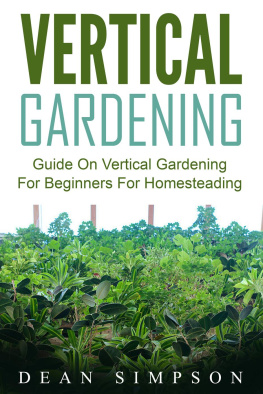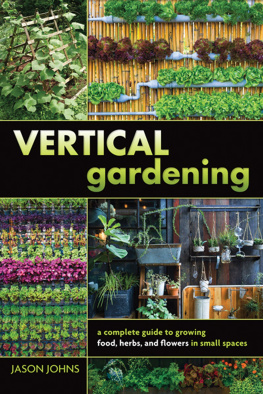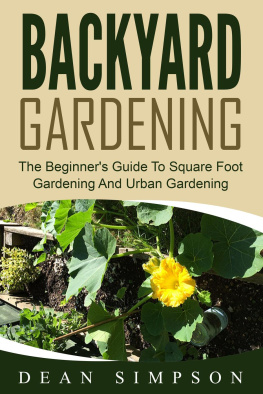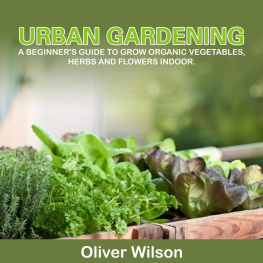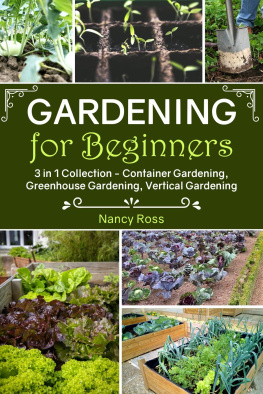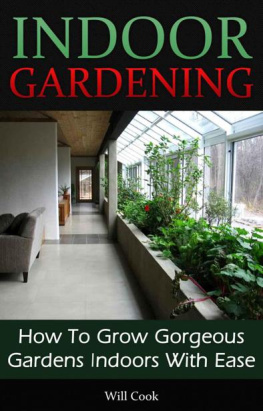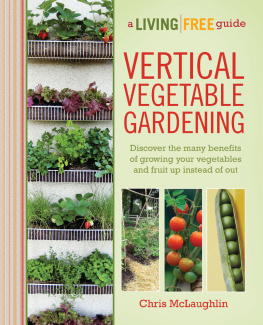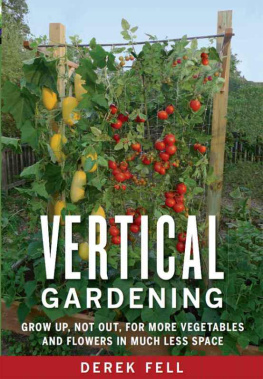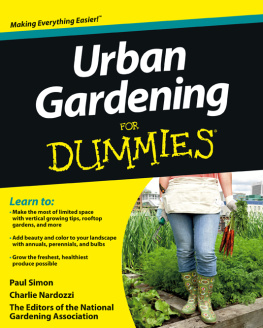Vertical Gardening Tips For Beginners
By
Timothy Tripp
Table of Contents
Vertical Gardening Tips For Beginners
By Timothy Tripp
Copyright 2013 Timothy Tripp
Reproduction or translation of any part of this work beyond that permitted by section 107 or 108 of the 1976 United States Copyright Act without permission of the copyright owner is unlawful. Requests for permission or further information should be addressed to the author.
This publication is designed to provide accurate and authoritative information in regard to the subject matter covered. This work is sold with the understanding that the publisher is not engaged in rendering legal, accounting, or other professional services. If legal advice or other expert assistance is required, the services of a competent professional person should be sought.
First Published, 2013
Printed in the United States of America
Introduction
Vertical gardening is the process of gardening that is done vertically or upward. While the traditional gardening process is gardening with plots on the ground, vertical gardening is a different approach to gardening as it aims to plant crops in a vertical position or standing position. This can either be done through hanging plots or with frameworks as long as plants are not planted on the ground like in traditional gardening.
There are several advantages of vertical gardening. One, vertical gardening is a great space saver. Since your garden is positioned vertically, it does not take up too much space in your backyard, giving room to more plants to be planted. Two, vertical gardening is a very flexible type of gardening because it allows you to plant or to build a garden even in an area with limited space. For instance, if you are only gardening on your rooftop or you only a have a very small backyard, it is possible for you to plant many crops through vertical gardening even with that limited space you have.
Three, you can create a beautiful garden through vertical gardening. In other words, you can beautify your garden space through it. This is because with vertical gardening, you can create plant structures like gates, walls of plants, etc. that could contribute greatly to the beautiful appeal of your garden. Four, vertical garden is highly advantageous in terms of accessibility. When it comes to harvesting or maintaining the garden, youll have easy access to your plants. There is no need for you to bend down.
Five, vertical gardening allows the crops you planted vertically to be healthier especially during summer where heat can destroy plants planted on plots. This is because when you have a vertical garden; air can easily circulate on your crops and make it a lot healthier. Most of all, vertical gardening allows you to plant a garden even in urban areas. In other words, if you live in a city where garden spaces are usually scarce, it is not impossible for you to own a garden if you go for vertical gardening since you dont need actual plots.
If you want to build a vertical garden, there are several things you need to be aware of. First, you need to how to know how to build one, you need to know how to prepare the soil for a vertical garden, you need to know how to maintain your vertical garden, and you need to know how to control pests and keep them from destroying your plants. This way, the time, money and effort you invested in building this garden wont be in vain. This book will discuss and reveal some of these helpful vertical gardening tips you need.
Chapter 1. How to Build a Vertical Garden
Building a vertical garden is not as easy as it seems to be. This is because you are going to have your plots positioned vertically and to do this is not easy. People who are not DIYers may have a hard time building a vertical garden without hiring someone to craft and build the garden for them. However, even if it is not easy, it is possible to be able to build a vertical garden on your own. You just have to follow some tips.
Create a vertical garden plan. Building a vertical garden is like woodworking too since to position plots vertically requires a framework. Since you are going to build a framework structure, you need to create a plan first. The plan should include the materials that you are going to use when building the vertical gardens framework. The plan also includes deciding how big or how small you want your vertical garden to be. Do you have enough space to create a very large vertical garden framework? All factors that need to be considered should be incorporated in the plan. Of course, when creating the plan, you also need to include where you plan to place the vertical garden. Creating a plan would make it easy for you to build the vertical garden.
Prepare the materials needed. When building a vertical garden, you need to make sure all the materials needed are prepared already. Usually, you would need large crates or crates of any sizes depending on the size of the vertical garden you want. You will also need chicken wire and seed starter cells.
Put soil into the crate and divide soil into individual cells. After you have prepared the materials, the next step is to put the soil into the crates. It is advised to divide the soil into different partitions or cells in order for you to have proper plant spacing when you are planting on your vertical garden already. The seed starter cells can help in this process. To make it easy for you to divide into cells, place the seed starter cells inside the crate and pour in the soil into the cells.
Make sure the seed bed is intact. Now, after you have put soil into the crates, they are still going to fall out if you let them stand. The important thing to remember when building a vertical garden is you need to keep the soil or the seedbed intact once they are positioned vertically. To do this, you need to install the chicken wire or the wire mesh and the moss to keep the dirt inside intact.
Hang on the wall or let it stand. If you are building a small vertical garden framework that can be hung on the wall, you can start hanging it already. If you are building a larger vertical garden, make sure that you have posts to support the crates. Make sure that you are using the right materials that would make your vertical garden framework sturdy.
Chapter 2. Preparing The Soil For Vertical Garden
Preparing the soil for your vertical garden is very important because the soil is the very basic ingredient you need to successfully build a garden. Just as you need to prepare the soil for a typical garden plot, you also need to prepare the soil for your vertical garden. Here are a couple of tips when preparing the soil properly.
Determine the right amount of soil to put on your vertical garden. The amount of soil you should put on your garden depends upon how big or how small your vertical garden is. For 15" x 24" pockets of vertical garden, the standard amount of soil to put should be at least 20 pounds.
Put a lot of compost. When preparing the soil, it is important to put a lot of compost to it. Remember that a good soil is the basic foundation of good plants on your garden. To make the soil for your vertical garden good, you must prepare it well by putting a lot of compost as compost can help nourish the soil and the plants so they would grow faster and healthier as well as produce more flowers and fruits.
Chapter 3. How to Maintain Vertical Garden
Now, once you have already built your vertical garden and planted plants on it already, that is not the end of your gardening. Just because your vertical garden is standing already does not mean youll have to pay no heed to it already and fail to maintain it. Maintaining your vertical garden is a must as this will ensure that all your plants will continue to grow well and produce good fruits and flowers all the time. Maintaining your vertical garden is also one way to reward the time, money and effort you have invested in building it. Here are some tips on how you can maintain your vertical garden and make sure maintenance is made easy.
Next page



